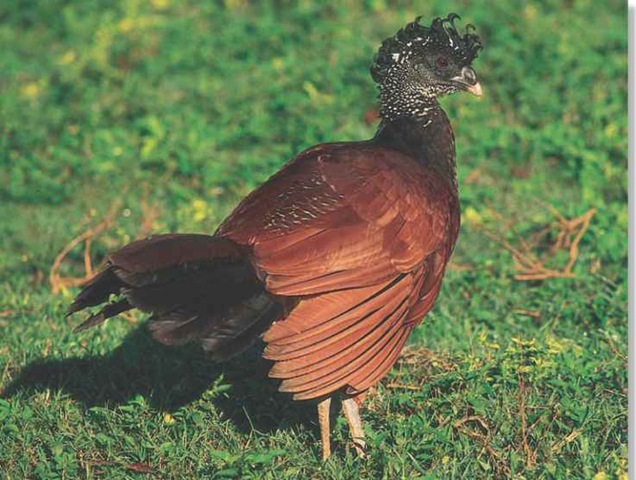ORDER
Galliform.es
FAMILY
Cracidae
GENUS & SPECIES
KEY FEATURES
Similar in appearance to a turkey, this game bird is the largest of the curassows Species has three different and unique female morphs but only one color for males Males have a loud booming call, which is amplified through an elongated windpipe
WHERE IN THE WORLD?
Found in Mexico, Central America, Colombia, Ecuador; also in Cozumel, the coast of Yucatan, Panama and Costa Rica
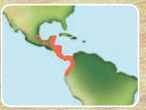
Lifecycle
A very poor flier, the great curassow uses its long legs to forage for food on the ground and flee for safety into the deep cover of its forest home.
Habitat
The sedentary great curassow rarely strays far from its forest habitat. This shy and reserved bird favors undisturbed, humid evergreen forests in South America and areas off the Mexican Gulf coast. However, its primary habitat is the heavy rainforest in tropical and lower subtropical zones, particularly lowlands, and foothills up to 4000′. Sometimes it will stray higher— in Panama, the bird has been spotted at 6,300′. The great curassow also e can be found in mangroves on the Pacific coast. It occurs seasonally in Costa Rica in drier forests and sometimes ventures into ravines and partially cleared areas. If left undisturbed, the curassow will even wander onto plantations.
Standout
The bird’s bill and plumage contrast with its forest home.
Behavior
Considering its relatively massive size, the great curassow shows surprising agility as it moves among the branches of its lush forest home. In flight, however; the large bird is nowhere near as elegant. With its rounded wings, the great curassow either glides or flutters awkwardly, with labored wingbeats, to the ground from its treetop perch. The mainly terrestrial curassow is not capable of sustaining prolonged flights and prefers to use its rather long legs to get around. In fact, when disturbed in its roost or while foraging for food on the ground, the great curassow will run, rather than fly, to safety. During elaborate courtship rituals and in the face of danger, males produce a loud, booming call that is amplified by an elongated trachea.
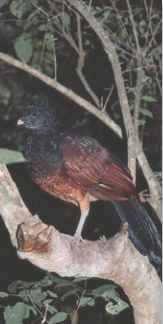
On high The great curassow perches gracefully on a tree branch.
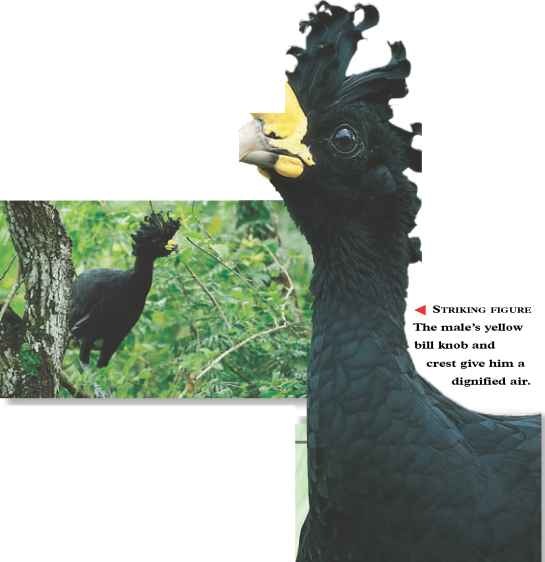
Conservation
Though not globally threatened, the great curassow is disappearing because of loss of habitat to the logging business; the bird is also hunted for its high-quality meat. However, healthy populations exist in protected national parks and reserves.
One female great curassow that was kept in captivity actually continued breeding until age 23.
The name curassow comes from the island of Curacao, which is located in the Caribbean, where Europeans first discovered the bird.
The great curassow is actually a relative of the domestic chicken, and is a prized game bird.
Food & feeding
The curassow flies down from the trees in its forest habitat to forage on the ground for fruit, berries or leaves, but it prefers to walk from place to place once it is on the ground. Using its powerful feet, the bird will scratch at the soil and leaf litter, picking up leaves and fallen fruit; the curassow especially favors figs and the exotic fruit of the Chione and Casimira trees. The curassow will pluck fruit from low branches or shrubs and glean insects from foliage. By swallowing small stones from the forest floor and using them to grind food in its gizzard, the game bird is able to digest even unripened fruit that is still green and hard. The curassow usually forages alone or in small groups of up to six birds.
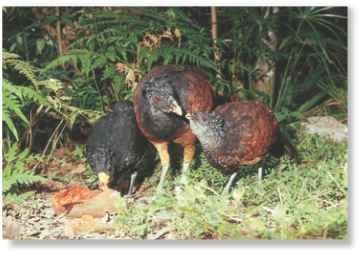
Low-down feeder
The great curassow forages on the forest floor for fruits and leaves.
Breeding
The curassow’s courtship ritual involves a series of sequenced movements. The male adopts a display posture, leaning forward with his breast very low to the ground. He then raises his head and tail and fluffs out his white abdomen feathers. He may stop to pick up a pebble and then toss his head back; he then drops the pebble before making the booming call. Following these displays, the female will enter his territory. Pairs are monogamous and breed from late winter to spring, depending on the region. Both sexes build an untidy nest of twigs and leaves in a bush or tree, no more than 6′ above the ground. There, the female lays her two eggs, which she incubates for 32 days with the male remaining nearby. Since the young are born with well-developed flight feathers, they are ready to leave the nest within a few hours.
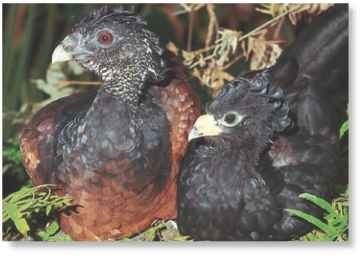
Cozy couple The protective mother watches over her chick.
putting on a show
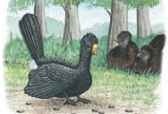
Show of style…
A male great curassow walks through a forest clearing in front of two females that are peering at him through the undergrowth.
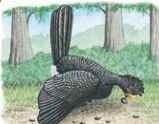
Making a move…
In a seemingly simple gesture, the male picks up a pebble from the ground in his bill. The tail is raised in display.
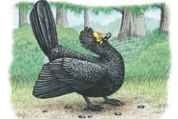
Theatrical flair…
The male dramatically throws his head against his back and drops the pebble to the ground, urgently flapping his wings several times.
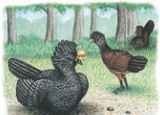
Resounding boom
The male squats and opens his bill, emitting a booming call that captures the attention of one of the nearby females.
Profile
Great Curassow
With his yellow bill knob, curly crest and glossy-black plumage, the male great curassow is a striking figure; females blend better into their habitat.
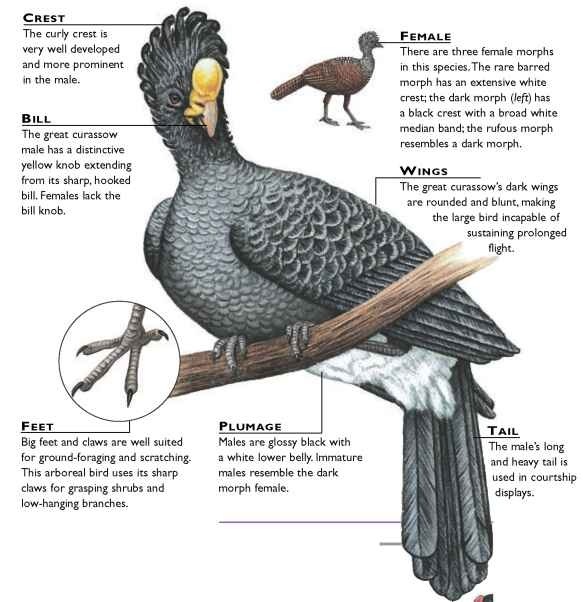
Creature comparisons
Like its relative, the razor-billed curassow (Mitu tuberosa) is also found in South America; it ranges in Amazonia, southeast Colombia, Brazil, Peru and
Bolivia. Like other curassows, this species favors humid forest and swampy areas in forests near streams. Its diet and feeding habits are also similar to those of the great curassow’s, consisting mostly of fruits, seeds, leaves and insects.The razor-billed curassow is smaller than the great curassow at 33-35″. While its crest is not as prominent as the great curassow’s, the razor-billed bird sports a massive casquelike red bill. Its plumage is similar to the curassow’s, but not as glossy.
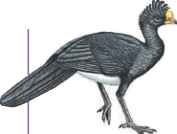
Great curassow
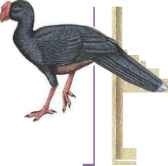
Razor-billed curassow
| VITAL | |
| STATISTICS | |
| Weight | 10.5 lbs. |
| Length | 30-37″ |
| Sexual Maturity | Probably 2 years |
| Breeding . : Season | February- . May |
| Number of Eggs | 2 |
| Incubation . Period | 32 days |
| Fledging Period | Unknown |
| Breeding Interval | 1 Year |
| Typical Diet | Fruit, leaves, berries and insects |
| Lifespan | 24 years in captivity |
RELATED SPECIES
• The great curassow is 1 of 7 species in the genus Crax, including the yellow-knobbed curassow, C. daubentoni, the bare-faced curassow, C. fasciolata, and the red-billed curassow, C. blumenbachii. There are 11 genera and 50 species in the family Cracidae, which includes chachalacas and guans. The curassows’ 4 genera include Pauxi, Mitu, Crax and Nothocrax.
